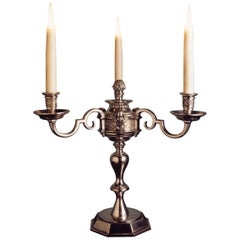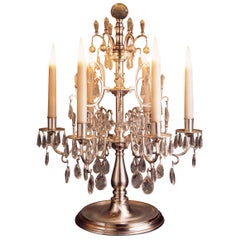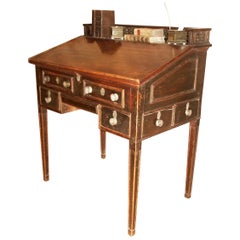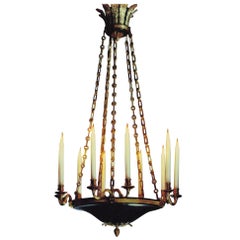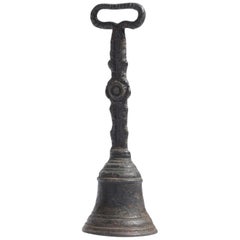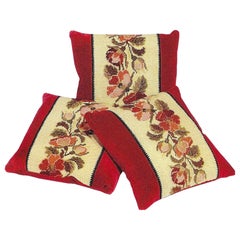Howgego Historic & Modern
to
236
202
108
102
89
89
53
45
41
32
29
26
24
23
21
20
18
18
17
14
12
12
12
10
10
10
9
9
9
8
7
7
7
6
5
5
5
5
5
5
4
4
4
4
4
4
3
3
3
3
2
2
2
2
2
2
1
1
1
1
4
3
2
2
2
Candelabra, 20th Century, English, Charles II Style, Silver Plated, Knole
Located in BUNGAY, SUFFOLK
This was adapted from the silver chandelier hanging at Knole in Kent, exclusively for use in a conservation project at Hampton Court. It has an antique, silver plated finish. There i...
Category
1990s Charles II Table Lamps
Materials
Silver Plate
Girandole, 20th Century, English Charles II, Silvered, Queen's House, Greenwich
Located in BUNGAY, SUFFOLK
This historically-accurate fitting was recreated exclusively for the conservation project at Queen’s House Greenwich in the early 1990s. It has a polished, silver plate finish. It ha...
Category
1990s British Charles II Table Lamps
Materials
Silver Plate
Bureau, 19th Century, English, Regency, Mahogany, Secret Drawers, Gallery
Located in BUNGAY, SUFFOLK
The top fitted with a removable gallery with fine brass filigree depicting lion heads and crowns amongst trailing stems. The mahogany, fall-front fitted with a later writing slope, a...
Category
Antique Early 19th Century English Regency Desks
Materials
Mahogany
Chandelier, Late 20th Century, Empire, 10 Branch, Wilkinson Plc
Located in BUNGAY, SUFFOLK
The polished brass acanthus leaf corona supports six rectangular split link chains holding a black painted bowl with an ormolu pendant. The five polished brass double candle...
Category
1990s European Empire Chandeliers and Pendants
Materials
Brass
Doorstop, 19th Century, English Victorian, Cast Iron, Bell, Rope Twist
Located in BUNGAY, SUFFOLK
The rope twist handle above an acanthus leaf stem terminating in the form of a bell.
Category
Antique Mid-19th Century British Victorian Doors and Gates
Materials
Brass
Pillow, Cushion, Set, 19 Century, French, Needlework, Crimson, Velvet
Located in BUNGAY, SUFFOLK
The pillows or cushions are made from late 19th century crimson velvet. This has been applied with 19th century needlework panels. The needlework has a cream ground embroidered with ...
Category
Antique Late 19th Century French Rococo Revival Pillows and Throws
Materials
Tapestry, Velvet
Plate Delftware, Inscribed 1744, Dutch, Great Yarmouth, Blue and White, Herring
Located in BUNGAY, SUFFOLK
The inside centre decorated with the inscription, “Great Yarmouth 1744”, surrounding the blazon of the arms of the town (three lions passant guardant in...
Category
Antique Mid-18th Century Dutch Baroque Delft and Faience
Materials
Earthenware
Cassone, Chest, Coffer, 17th Century, French, Louis XIV, Walnut
Located in BUNGAY, SUFFOLK
Lovely cassone with classical form, the beautiful figuring of the oak creates subtle, decorative patterning and the simple mouldings give a light, contemporary feel.
The rich, lustr...
Category
Antique Late 17th Century French Louis XIV Blanket Chests
Materials
Walnut
Countye of Monmouth, Dated 1610
By John Speed
Located in BUNGAY, SUFFOLK
The countye of Monmouth with the situation of the townshire described Anno, 1610
The reverse with Monmouthshire, Chapter VI and an alphabetical list of towns.
In a beautiful Flemish oak polished and gilded frame
Cartographer: John Speed...
Category
Antique 1610s English Baroque Decorative Art
Materials
Paper
Wall Plaque Dutch, 18th Century, Delftware, Blue and White, Chinoiserie, Pottery
Located in BUNGAY, SUFFOLK
Cartouche-shaped with a lady standing beside a fence on a terrace amongst blossom sprays and peonies with an acrobatic bird and insect flying overhead. The border in moulded relief w...
Category
Antique Mid-18th Century Dutch Baroque Delft and Faience
Materials
Earthenware
Grotto, Table, Oak, 19 Century, Serpent, Carved, Scroll, Medullary Ray
Located in BUNGAY, SUFFOLK
Lovely, carved detailing the the edge of the top and rococo scrollwork stem and feet which incorporate shell detailing inside the scrolls
This table is crisply carved with characteristic grotto ornamentation creating the form with the scrollwork stem and legs carved with shell and other motifs. The top has an unusual 4cm carved acanthus leaf edge.
The use of oak shows that, unlike much grotto furniture...
Category
Antique Mid-19th Century British Baroque Side Tables
Materials
Oak
Knole Settee, 19 Century, English Baroque, Upholstered, White, Linen
Located in BUNGAY, SUFFOLK
The straight, padded back re-upholstered in a modern linen to give a contemporary aesthetic.
Originally with red velvet and embellished with 18th century, braid, fringe and tasse...
Category
Antique Late 19th Century English Baroque Settees
Materials
Linen
Panel, Late 19th Century, French, Antiquarian, Romayne, Carved, Oak
Located in BUNGAY, SUFFOLK
This panel is beautifully carved and has developed a lustrous patina over time.
Category
Antique Mid-19th Century French Greek Revival Decorative Art
Materials
Walnut
Table, Hare Carcass, Sculpture, 2009
By Laurence Edwards
Located in BUNGAY, SUFFOLK
Laurence Edwards A.R.B.S. (B. 1967): Hare carcass table sculpture, modelled from observational studies
Bronze, united with 1 ¼ in thick, 17th century Spanish fruitwood top.
This t...
Category
Early 2000s British Modern Sofa Tables
Materials
Bronze
Coach, Panel, 18 Century, English, George III, Coat of Arms, or, Gilded, Eagle
Located in BUNGAY, SUFFOLK
Few coach panels survive. This is a striking example with the double headed eagle, gilded armorial and burgundy background.
The closest I can find to ar...
Category
Antique Late 18th Century English George III Paintings
Materials
Mahogany
Ottoman, Leather, 19th Century, English, Victorian, Mahogany, Serpentine, Tufted
Located in BUNGAY, SUFFOLK
Serpentine-shaped ottoman, mid-19th century, English, Victorian, with mahogany skirt and feet and upholstered in burgundy leather
This handsome ottoman is really practical offering ...
Category
Antique Mid-19th Century English Victorian Blanket Chests
Materials
Leather
Pelmet, Tapestry, Baroque, 19th Century, Brussels, Morant & Co.
By Morant & Co.
Located in BUNGAY, SUFFOLK
This pelmet is exceptionally long. The Brussels tapestry is finely woven with fruits and trailing stems and the colours are not faded. It works as a hanging in its own right, but could also be adapted as a curtain or bed pelmet...
Category
Antique 1880s Baroque Curtains and Valances
Materials
Tapestry
Chair, 20th Century, English, Modern, Upholstered, Mink
Located in BUNGAY, SUFFOLK
The back and seat fully upholstered in a fawn colored mink. Standing on turned ebonised front legs with brass cappings and tapering ebonised back legs.
Measures: Width 51 cm, 20 ...
Category
Mid-20th Century English Mid-Century Modern Chairs
Materials
Fur
Table, 18th Century, Swiss, Baroque Oak Top, Slate
Located in BUNGAY, SUFFOLK
An 18th century, oak top with slate inset united with a contemporary, Spanish influenced, low, iron base
This table is very striking and an ideal height to be used as an occasiona...
Category
Late 20th Century Modern Sofa Tables
Materials
Slate
Chest, Cassone, 17th Century, Portuguese, Baroque, Brazil, Hardwood
Located in BUNGAY, SUFFOLK
This striking chest is made from a Brazilian hardwood which I have not been able to identify. The color and figuring of the timber together with the Classic form and ornamentation su...
Category
Antique Late 17th Century Portuguese Baroque Blanket Chests
Materials
Hardwood
Armchair, Pair, Hunting Trophy, Antler, Red Deer, Fallow, Wild Boar, Hide
Located in BUNGAY, SUFFOLK
Pairs of hunting trophy armchairs are exceptionally rare. This pair are also unusual because they are made from a few large antlers giving them a minimalist quality. The fluid form of the antlers creates a sculptural, organic aesthetic. They are also usable and very comfortable. It has taken great skill to make these chairs, selecting massive antlers to create exquisite form and stability within a minimalistic, sculptural aesthetic. They are dramatic and unusual injecting a naturalistic and organic gravitas to any interior which reflects the grace, agility and presence of the kings of forest that they came from.
The impressive crestings, sides and front stretchers on each armchair are made from five magnificent fallow deer antlers. The arms and supports on each chair are made from eight massive red deer antlers. The antlers are arranged creatively to create both, a stable structure and sculptural form. The seats are upholstered in wild boar hide.
Dimensions: Width 91cm., 35.83in., Height 132cm., 51.97in., Depth 96cm., 37.80in.
Museums With Collections Of Antler Furniture
• Victoria & Albert Museum, London
• Museum casle trautenfels, Trautenfels – Austria
• Museum of natural history, Venice
• Palace Museum, Beijing
“There is grace and movement in the antler itself. They’re one of the most beautiful forms in nature…” Gail Flynn
Hunting trophies have been used as source material for clothes hooks, storage racks and lamps since the 15th century. Mounting antlers and stuffed heads on walls provided impressive, decorative displays for hunting trophies. A hunting lodge replete with antlers and stuffed animals was most likely where ideas for antler furnishings emerged.
At the beginning of the 19th century antler furniture was made exclusively for the European nobility to decorate palaces, castles and country seats. The furniture was either made completely from stag antler, or it was decorated with antler pieces from the stag, deer, fallow deer and others, or veneered with sliced antler pieces to create a hunting design.
The first recorded antler furniture dates from 1825, made for a hunting castle of Count William of Nassau near Wiesbaden, Germany. Other famous collections of historical antler furniture are the hunting room in the country estate of the brandhof of Archduke Johann of Austria or the antler collection of Count Arco in his palace in Munich, Germany. There are hundreds of drawings of creative antler decorations by the Austrian furniture maker Joseph Danhauser (1780-1829).
In 1851, chairs, chests of drawers and a sofa made of horns were exhibited at the Great Exhibition Of The Industries Of All Nations in London which were considered one of the great novelties of this iconic exhibition. This created a new lifestyle trend and fashion driven by the ambitious European middle-class and antler furniture disseminated into bourgeoisie households. One of the first designers is the German ivory carver and furniture maker H. F. C. Rampendahl who gained enthusiastic successes on several world exhibitions with his antler furniture. An antler bureau, a horn seating group or individual chairs, decorated gun cabinets, H.F.C. Rampendahl created a whole new design world for fashioning rooms. This prompted other designers in Germany Austria and USA to make antler furniture H.F.C. Rampendahl, Hamburg, P. Keutner, Regensburg, Vitus Madel & Son, Ichenhausen, Kurt Schicker, Regensburg, Heinrich Keitel, Vienna, Rudolf Brix...
Category
Antique Late 19th Century European Victorian Armchairs
Materials
Antler, Hide
Console, Table, Painted, Steel, Bronze, Lion, Sculpture
Located in BUNGAY, SUFFOLK
A painted steel, console table with a shaped frieze inspired by a 17th century, Flemish cabinet. Standing on turned legs joined by an ‘H’ stretcher with a bronze, sculpted lion on on...
Category
Early 2000s English Post-Modern Console Tables
Materials
Bronze, Steel
Chair, 19th century, Italian, Baroque, walnut, upholstered, Missoni
Located in BUNGAY, SUFFOLK
The tapering back and rectangular seat re-upholstered in a Missoni fabric. Characteristic boldly turned legs and blocks, the back legs straight. Good colour and patina.
Back hei...
Category
Antique Late 19th Century Italian Baroque Office Chairs and Desk Chairs
Materials
Walnut
Desk, Vintage, Mahogany, Gilding, Book-Spine Form Drawers, History of England
Located in BUNGAY, SUFFOLK
I have never seen a desk like this before, it is really quirky, a great conversation piece.
Tan leather top with gold leaf embossed tooling surrounded by crossbanding. The frieze wi...
Category
Vintage 1980s English Post-Modern Desks
Materials
Giltwood, Mahogany
Chest, Coffer, 17 Century, German, Baroque, Oak, Marquetry, Inlay, 30 cubic feet
Located in BUNGAY, SUFFOLK
This vernacular chest exudes character and charm. The moulded panels and inlay inject gravitas. It has a lovely mellow lustrous patina. It is unusual being large and providing a copi...
Category
Antique Early 17th Century German Baroque Blanket Chests
Materials
Oak
Bed, 19th Century, Italian, Baroque, Carved, Painted, Gilded, Armorial Cartouche
Located in BUNGAY, SUFFOLK
The headboard is surmounted with a carved cresting and turned finials at each end, and the frame painted with scrollwork. The centre of the headboard has a cartouche containing a pai...
Category
Antique Late 19th Century Italian Baroque Beds and Bed Frames
Materials
Beech
Cassone, 17th Century, Italian, Baroque, Vernacular, Walnut, Carved, Hearts
Located in BUNGAY, SUFFOLK
This handsome cassone has ornament with romantic associations and was most likely a marriage chest. It is a good example of the Italian vernacular, simple in a sophisticated manner. ...
Category
Antique Late 17th Century Italian Baroque Blanket Chests
Materials
Walnut
Lamp, Vintage, Tree, Arbre, Carving, Style of Diego Giacometti, Gilded
By Diego Giacometti
Located in BUNGAY, SUFFOLK
This lamp is in the spirit of Diego Giacometti who used a stylised tree motif as stand-alone sculpture and also as sculpture to embellish his bronze furniture. A pair of these tree s...
Category
Mid-20th Century Italian Mid-Century Modern Table Lamps
Materials
Walnut
Bench, Pair 18th Century, French, Vernacular, Provincial, Elm, Trestle
Located in BUNGAY, SUFFOLK
Single plank tops, lovely shaped ends on trestle feet. Exceptional original color and patina.
Category
Antique 1780s European French Provincial Benches
Materials
Elm
Candlestick Torchere Massive Pair Italian Baroque Beech Carved 40" high
Located in BUNGAY, SUFFOLK
One 85 cm + 10 cm pricket
Other 89 cm high + 10 cm pricket
Just purchased more information to follow.
Category
Antique 1690s Italian Baroque Table Lamps
Materials
Beech
Curtains, Set of 3, Silk Velvet, Charles II-Style, Burgundy Damask Cowdray Park
Located in BUNGAY, SUFFOLK
Each with a damask pattern of scrolling foliage, peonies, tulips and fruit. Massive pattern repeat, see image. Original braid. Cleaned and conserved.
Measures: Two height 315 cm., 124 in., width 107 cm., 42 in.,
One height 295 cm, 116 in., width 109.5 cm., 43 in.,
From the collection of the 1st Viscount Cowdray, Cowdray Park, Sussex, supplied by Lengyon & Co, circa 1910.
Francis Lenyon, Lenyon & Co, Lenyon & Morant
Born in England in 1877, Lenyon was trained as a cabinetmaker and studied at the South Kensington Museum in London. By 1900, he found work with Art Workshops, Ltd., and soon after with Charles Duveen, son of Sir Joseph Duveen. Employed by C.J. Charles for several years, Lenyon became well-known as cabinetmaker to England's aristocracy. He opened his own firm, Lenyon & Co., in 1904, and in 1912 merged with Morant & Co., to become Lenyon & Morant, holding royal warrants under four successive British kings.
In 1910, Lenyon made his first visit to the United States to supervise the interior decoration of Whitlaw Reid, and soon opened a New York branch of his firm. As in England, Lenyon 's American clients were wealthy and sophisticated and relied on Lenyon to furnish authentic and reproduction interiors in period styles. In the 1930s, Lenyon was hired by Nelson Rockfeller to serve as a major consultant to the reconstruction of Colonial Williamsburg in Virginia, and selected all the furnishings for the Governor's Palace there.
Lenyon was widely known for his expertise in 17th and 18th century British furniture...
Category
Early 20th Century European Charles II Curtains and Valances
Materials
Velvet
Casket, German, Baroque, painted, Vivien Leigh, Laurence Olivier, Notley Priory
Located in BUNGAY, SUFFOLK
This charming and unusual casket injects a romantic atmosphere into any interior. It has survived in impeccable condition with acceptable wear to the painted surface which signifies its age and use. It is a conversation piece, a piece of acting history, bought by Vivien Leigh and Laurence Olivier...
Category
Antique Mid-17th Century German Baroque Decorative Boxes
Materials
Oak
Table, Centre, Library, Desk, 17 Century, Portuguese, Baroque, Brazil, Rosewood
Located in BUNGAY, SUFFOLK
The design and ornamentation of this centre table is characteristic of Portuguese Baroque furniture dating from the second half of the 17t...
Category
Antique Late 17th Century Portuguese Baroque Center Tables
Materials
Rosewood
Settee, 1950, French, 3-Seat, Upholstered, Red, Velvet, John Piper
By John Piper
Located in BUNGAY, SUFFOLK
Incorporating 'Stones of Bath' into this settee is inspired the pipers use of one of the five designs commissioned for their centenary, ‘The Glyders’, as loose covers for the chairs at their home Fawley bottom which John Betjeman called ‘Fawley Bum’.
'Stones of Bath' is one of five John Piper (1903-1992) designs commissioned by Arthur Sanderson & Sons in 1959 for their 1960 centenary celebrations. In 1962 Sanderson's screen printed ‘Stones of Bath’ on their Sanderlin fabric, a satinised linen which gave the design a shimmering, restless texture. This was ideally suited to the play of light depicted on the stone in the architectural repeat of buildings in the city of Bath.
A piece of this fabric which is in the collection of the V&A was exhibited at the John Piper retrospective held at the Tate Gallery, London, 1983. Reference: 'Artists’ Textiles in Britain 1945-1970', Cat. No. 74.
From the late 1950s-early 1960s there was interest in painterly textiles that demonstrated the unique potential of screen printing, with its ability to capture the quality of brush-stroked color. 'The monumental grandeur of many artists' textiles in the early 1960s was necessary if they were to work in the large scale architectural interiors of the era which witnessed a rapid growth in new public buildings, all which required furnishing with suitably prestigious fabrics'. Artists' Textiles in Britain 1945-1970 by Geoffrey Rayner, Richard Chamberlain...
Category
Mid-20th Century British Modern Settees
Materials
Velvet
Chairs Set of 4 18th Century, Portuguese, Baroque, Parcel-Gilt, Walnut, Bargello
Located in BUNGAY, SUFFOLK
This elegant set of chairs relate to a set of twelve chairs and a settee from the collection of D. Joa~o V, King of Portugal. The parcel gilding gives...
Category
Antique Early 18th Century Portuguese Baroque Chairs
Materials
Walnut
Table, Low, Sofa, Coffee, Specimen, Marble, Pietre Dure, Iron, Marcel Coard 57"L
Located in BUNGAY, SUFFOLK
MASSIVE 145CM, 57” LONG, VINTAGE, SPECIMEN MARBLE, TOP UNITED WITH AN IRON BASE IN THE MANNER OF MARCEL COARD
Striking conversation piece with 143 marble...
Category
Mid-20th Century Italian Mid-Century Modern Sofa Tables
Materials
Marble
Vargueno, Bargueno, Escritorio, Taquillon, Spanish, Baroque, Walnut, Velvet
Located in BUNGAY, SUFFOLK
Spanish writing desks of this period are the most distinctive pieces of Spanish furniture conceived as visual displays of incredible virtuosity. The characteristic decoration of the ...
Category
Antique Early 17th Century Spanish Baroque Cabinets
Materials
Walnut
Settee, Sofa, Pair of 6-Seat, Custom Made, Terence Conran, Sutton Place
Located in BUNGAY, SUFFOLK
This massive pair of 6-seat sofas were commissioned as part of Stanley J Seeger’s remodeling and grand redecoration of Sutton Place. They are upholstered ...
Category
Vintage 1980s British Modern Sofas
Materials
Cord
Chair Stool Hall Sgabello Pair 16 Century Venetian Renaissance Carved Sculpture
Located in BUNGAY, SUFFOLK
The quality of these exhuberant backstools demonstrate why Italian Renaissance furniture was as highly prized as old-master paintings. Th...
Category
Antique 16th Century Italian Renaissance Chairs
Materials
Walnut
Chandelier, 6-Arm, Gilt-Brass, Glass, Edwardian Rococo Revival
Located in BUNGAY, SUFFOLK
EDWARDIAN, 6-ARM, GILT-BRASS & GLASS CHANDELIER IN THE ROCOCO STYLE 17½ ” high
The lightness, elegance, and an exuberant use of curving and floral ornamentation are characteristic ...
Category
Early 20th Century British Edwardian Chandeliers and Pendants
Materials
Brass
Armchair chair 17th Century English Walnut Needlework X-Stretchered, Scroll
Located in BUNGAY, SUFFOLK
An exceptional, museum quality, English, baroque, walnut, open armchair with faceted legs and shaped ‘x’ stretcher, upholstered in fine Georgian needlework...
Category
Antique 17th Century English Baroque Armchairs
Materials
Walnut
Armchair, chair, 17th Century, Italian, Walnut, Scroll, Baroque, Tapestry
Located in BUNGAY, SUFFOLK
This elegant armchair exudes classic gravitas, with scroll arms, fall turnings and triple toe feet
The tapestry back depicting Flora underneath a bower is a distinctive feature. It...
Category
Antique 17th Century Italian Baroque Armchairs
Materials
Walnut
Corner Cupboard, 17th Centuy, English, William & Mary, Vernacular, Oak
Located in BUNGAY, SUFFOLK
This is a fine vernacular piece with simple but bold ornamentation and a rich lustrous patina.
The top with a moulded cornice. The front fitted with a single door with crisp moul...
Category
Antique Late 17th Century European William and Mary Corner Cupboards
Materials
Oak
Wallhanging, 2003 Recreating a 1850s Design by Jacques Dulud, Leather Embossed
Located in BUNGAY, SUFFOLK
The gilded, stylised scrolling foliage design is embossed into the grey leather enhancing the effect of the relief. The eighteen panels were pressed from moulding blocks which were m...
Category
Early 2000s English Baroque Decorative Art
Materials
Leather
Torchere or Candlestand, 17th Century, Italian, Baroque, Walnut, Floor-Standing
Located in BUNGAY, SUFFOLK
The metal pricket and drip-tray surmounding the baluster, ring and barley-twist turned stem which is supported by and elaborate acanthus-leaf and scroll carved base terminating in lion-paw feet. Excellent original color and patina.
Provenance: Private Collection, purchased Derek Green...
Category
Antique Late 17th Century Italian Baroque Candle Stands
Materials
Walnut
Trestle Gateleg Table, Museum Piece English Jacobean Cedarwood, Panelled
Located in BUNGAY, SUFFOLK
- This table is the most original and superior example of a small surviving group of a rare, early model of gateleg table dating between 1620 and 1650.
- It is more sophisticated t...
Category
Antique Early 17th Century English Jacobean Center Tables
Materials
Cedar
Fireback, Cast Iron, 17th Century, English, Bearing the Initials W S
Located in BUNGAY, SUFFOLK
Fireback, cast iron, 17th century, English, bearing the initials W S.
Category
Antique 17th Century English Baroque Fireplaces and Mantels
Materials
Iron
Fireback, Cast Iron, Dated 1685, Initialled HVE Twice
Located in BUNGAY, SUFFOLK
Fireback, cast iron, dated 1685, initialled HVE twice.
Category
Antique 17th Century English Baroque Fireplace Tools and Chimney Pots
Materials
Iron
Armchairs, Pair, Flemish, 17th Century, Walnut, Upholstered, Bargello, Scrollarm
Located in BUNGAY, SUFFOLK
This pair of open armchairs are characteristic of the Haute Époque employing elegant barley-twist turnings and sweeping, curved, scroll arms. The bargello is a re-creation of a fashi...
Category
Antique 17th Century Dutch Baroque Armchairs
Materials
Walnut
Armchair, Flemish Walnut Upholstered Bargello Scroll Arm Barley twist Baroque
Located in BUNGAY, SUFFOLK
This open armchair is characteristic of the Haute Époque employing elegant barley-twist turnings and sweeping, curved, scroll arms. The bargello is a re-creation of a fashionable uph...
Category
Antique 17th Century Dutch Baroque Armchairs
Materials
Walnut
Mirror, 17th Century, Small, Spanish, Gilded, Papier Mache, Original Plate
Located in BUNGAY, SUFFOLK
This charming small mirror has survived in extraordinary condition with its original gilding and mirror plate which is very unusual particularly for a piece made from a delicate medi...
Category
Antique Mid-17th Century Spanish Baroque Wall Mirrors
Materials
Paper
Knole Armchair, English, Morant & Co, Green Strie Velvet
By Morant & Co.
Located in BUNGAY, SUFFOLK
This is an early 20th century interpretation of an armchair inspired by the infamous, sumptuously, upholstered, 17th century, couch with hinged arm rests, found at Knole Park, Sevenoaks, Kent, the ancestral seat of the Sackvilles made by the most eminent upholsterer of the early 20th century. The original couch served the dual purpose of bed and settee, and is one of the earliest examples of English, upholstered, seat furniture. This is a particularly fine example, with a Morant & Co provenance. A matching 3-settee is also available
The inside and outside back, wings, seat and cushion are upholstered in green strie velvet and trimmed in the traditional manner with matching braid and fringe. The strie velvet could be original, if this armchair has been lightly used, as there is significant fading from the original bright green. The adjustable padded wings are joined to the arms with original ratched iron hinges which are attached to the back. The arms are supported by oak turned uprights. The seat has a large loose cushion. Standing on original castors. English, circa 1900.
Bearing the fabric retail label of Morant & Co Upholsterers, Decorators. 91 New Bond St., London. with Royal Coat of Arms, dated 1825, 1831, 1837 & 1890, founded 1790.
During the late 16th-early 17th century a new form of day-bed was introduced to match the contemporary upholstered ‘X’ chairs and stools. They were padded and upholstered throughout and the ends were let down on a toothed steel ratchet to enable the occupant to repose at full length. They were generally destroyed when the coverings had worn out at the woodwork was of little value. Similar couches were plentiful in France under Louis XIII and can be seen in Abraham Bosse’s engravings of domestic interiors but they were only found at Court and the houses of great noblemen in this country. When the contents of the Royal Palaces were dispersed after Charles I’s execution a number of couches were included in the sale.
Morant & Co (fl.1885-1915)
The dictionary of English furniture makers 1660-1840, published by the Furniture History Society informs that Morant Snr. was a maker of carved and gilded frames from early in the reign of George IVth, and his trade card describes the company as ‘Ornamental Painter and Paper Hanging Manufacturer to their Royal Highnesses’. Work was executed for Sir Thomas Lawrence, Sir Robert Peel...
Category
Antique Early 1900s English Baroque Revival Armchairs
Materials
Velvet
Commode, Early 18th Century, Italian, Venetian, Baroque, Walnut, Serpentine Front
Located in BUNGAY, SUFFOLK
The serpentine front on this magnificent commode is sophisticated and gives it gravitas. It has a rich colour and lustrous patina and has come from a private collection, Semenzato Ve...
Category
Antique Early 18th Century Italian Baroque Commodes and Chests of Drawers
Materials
Walnut
Commode, 18th Century, Italian, Venetian, Walnut, Small, Original Brassware
Located in BUNGAY, SUFFOLK
This Classic 18th century model is a rare, small size with a rich color and lustrous patina. From a private collection, Semenzato, Venezia.
Single plank top with solid moulded edge. The frieze with a band of gadrooned carving at the top. Below three drawers mouled with fine figuring original brass handles, escutcheon and locks only the top lock working. The pine drawers are lined with a block printed...
Category
Antique Early 18th Century Italian Baroque Commodes and Chests of Drawers
Materials
Walnut
Lantern, Delftware, mid-18th Century, Dutch, Polychrome, Tryhoorn Collection
Located in BUNGAY, SUFFOLK
This charming lantern decorated with typical Dutch estuary scenes is a rare survival. Although they must have been made in large quantities as evidenced in many Dutch Old Masters th...
Category
Antique Mid-18th Century Dutch Baroque Delft and Faience
Materials
Earthenware
Fishing Float, Early 20th Century, Glass, Rope, Ornament, Sea, Fishermen
Located in BUNGAY, SUFFOLK
Fishing float, early 20th century, glass, rope,
One of a collection of, early 20th century, glass & rope, fishing floats of different sizes. There are three floats of this size
T...
Category
Early 20th Century European Art Deco Nautical Objects
Materials
Rope, Glass
Near Pair of Candle Stands or Torchères, Late 17th Century, English
Located in BUNGAY, SUFFOLK
Due to their utilitarian nature, surviving pairs of 17th century candle stands/torchères are extremely rare and generally only seen today in great houses. The quality of the marquetry decoration and the attention to detail indicate that these candle stands were probably made for a substantial household. The turned stems displays the skill of the turner, and create fluidity, variety of form, emphasing the quality of the solid walnut grain and the floral inlay as well as holding and balancing the form of the top. The sweeping, scroll feet balance the proportion and fluidity of the candle stands/torchères, giving them presence. They are sturdy and in excellent condition.
Virtually identical turnings and form. Both with octagonal tops, one with a central marquetry floral spray, the other plain. The upper sections with solid walnut baluster and ring turnings leading into lower octagonal sections decorated with marquetry floral sprays repeated 3 times. The stems supported by octagonal blocks with a repeat of the floral spray and scroll tripod bases with two floral sprays on the upper facing sections. Excellent original colour and patina. English.
Height 96cm, Top diameter 29cm
Moveable stands to support a candlestick or lamp were intended to supplement the fixed lighting arrangements of rooms. The evidence of inventories suggests that they did not become common in France until about 1650 when they accompanied fine tables and cabinets. Such stands, being sometimes in the form of gueridons.
The fashion for decorative candlestands spread rapidly after the Restoration, when they were often made en-suite to flank a sidetable with a mirror above. Such sets are mentioned in lists of household goods and by contemporary writers. In 1664, for instance, Mary Verney is anxious to obtain “a table and stands of the same coler”. The Academy of Armory, published in 1688, defines a candle-stand as a “little round table...
Category
Antique Late 17th Century English William and Mary Candle Stands
Materials
Walnut
Table Cabinet, Mid-17th Century, Flemish Baroque, Ebonized and Tortoishell
Located in BUNGAY, SUFFOLK
This cabinet was made in Flanders in the mid-17th century as a prestigious item for an affluent member of the professional classes. The significant amount of tortoishell employed dem...
Category
Antique Mid-17th Century European Baroque Cabinets
Materials
Tortoise Shell
Set of Eight Tapestry Pillows Cushions Mid-17th Century Flemish Baroque Verdure
Located in BUNGAY, SUFFOLK
These pillows or cushions are made from two complete borders of a 17th century verdure tapestry so they are in aesthetic harmony. They depict profuse floral sprays and each cushion h...
Category
Antique Mid-17th Century European Baroque Textiles
Materials
Tapestry
Table Cabinet, Early 17th Century, Italian Baroque, Pietra Paesina Mounted Walnu
Located in BUNGAY, SUFFOLK
This cabinet is one of a small group that were made in the 1620s as taste and fashion veered towards the use of a paesina stone with its characteristic evocative veining which exhibi...
Category
Antique Early 17th Century Italian Baroque Cabinets
Materials
Marble
